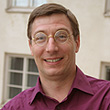Powerful Poster Presentations
This entry was written by Sabine Göke, head of the radar group at the University of Helsinki in Finland. She was awarded the Spiros G. Geotis Prize for her first poster presentation at the 28th American Meteorological Society Conference on Radar Meteorology, Austin, Texas, USA.
Poster presentations are an effective communication medium allowing viewers to absorb the content at their pace and promoting the exchange of ideas. Thus organizers of some of the most prestigious conferences seek to stimulate fruitful discussions and innovative ideas almost exclusively through the use of this medium. For poster sessions to be successful conference organizers have to plan them well and authors must use their creativity to achieve great visual impact, clarity and readability of their posters. The stigma attached to the term “poster session” is thus a serious misconception when it comes to well-prepared posters and well-planned poster sessions.
Poster presentations differ from oral presentations mainly by the fact that the audience is not a captive one: individuals have to come to the poster. Thus it is essential to know, which criteria do members of the audience apply in order to decide whether or not they will finally start to discuss the work with the author. As presenter you have to attract your audience by making your poster to stand out. It is important to make your poster at the same time easily readable and visually attractive. Giving the layout a clear structure, making good use of colors, and using at least 50% of the surface area for photos, graphs and diagrams will achieve a good overall visual impact. As a Ph.D. student, preparing my very first poster for a scientific conference in 1997, I chose to present high quality photographs of the measuring sites in the Swiss Alps. These photographs attracted viewers particularly those who had visited Switzerland as tourists and recognized the displayed landscape. This familiar element made it easy for everyone to overcome initial inhibitions.
I am a strong advocate of “less is more”. Having attended many poster sessions as audience, I can say from experience that the shorter the text the greater the chance that I will read your poster. Since posters must be constructed as a self-explanatory medium being able to stand alone with additional no verbal comments necessary, ad only as much words as needed, use flow diagrams, key-word lists and simple concept maps. Do refrain from copying your introduction of the extended abstract that is published separately – no matter how well it is written. If you need to rely on text, use letters at least 7 mm high and generous line spacing.
Poster presentations permit considerably more informal questions and answers than oral presentations. You can encourage discussions when designing your poster through presenting provocative material and declaring it as such. Place question marks on results you find unusual or inexplicable. For my first poster presentation, I attached transparencies to hold on top of graphs to visualize the comparison of model results and measured data. This interactive element encouraged members of the audience to touch my poster and as a result increased the level to which they became interested in discussing my findings.
Equally important however is the organization of the poster session. Critical factors that affect the success of any poster sessions are space, light, and timing. Besides sufficiently large poster boards, adequate space in front of each poster and ample space between isles, organizers ought to offer more: Using only one side on each poster board per session keeps isles clearer, using only every second poster board per session allows for larger crowds in front of each poster. Yet all this has to be achieved by keeping the numbering clearly arranged. Allowing for additional material like e.g. laptops on small tables in front of poster boards helps making poster session very lively. Light should illuminate each poster sufficiently well. If the light reflects strongly from glossy surfaces, authors of poster presentations should be informed beforehand to not laminate their posters. Finally timing is very important: I strongly believe that no more than 30 posters should be presented within a two-hours poster sessions. Combining poster sessions with a coffee break after lunch or with a reception at the end of the day has also been proven to be very effective.



HI,
Well made points about posters. Perhaps there ought to be some way to “preview” thumbnail images of posters with their abstracts? Visual and neuroscience learning theories
point out the importance of “images”.
And, would have loved to have seen your poster(s) since we are talking “visuals” here.
Thanks for posting.
Joe
Hi Joe,
Thanks for your comments. I don’t have any good posters to show off other than the ones that I’ve already posted here. http://eloquentscience.com/2011/02/rethinking-poster-sessions-as-second-class
You might check out Colin Purrington’s page at http://colinpurrington.com for good and bad examples.
You can see award-winning posters from a conference for the Atmospheric Radiation Measurement program at http://stm.arm.gov/2009/09awards.stm where Chief Scientist Warren Wiscombe is an outspoken advocate of high-quality posters.
Best,
Dave